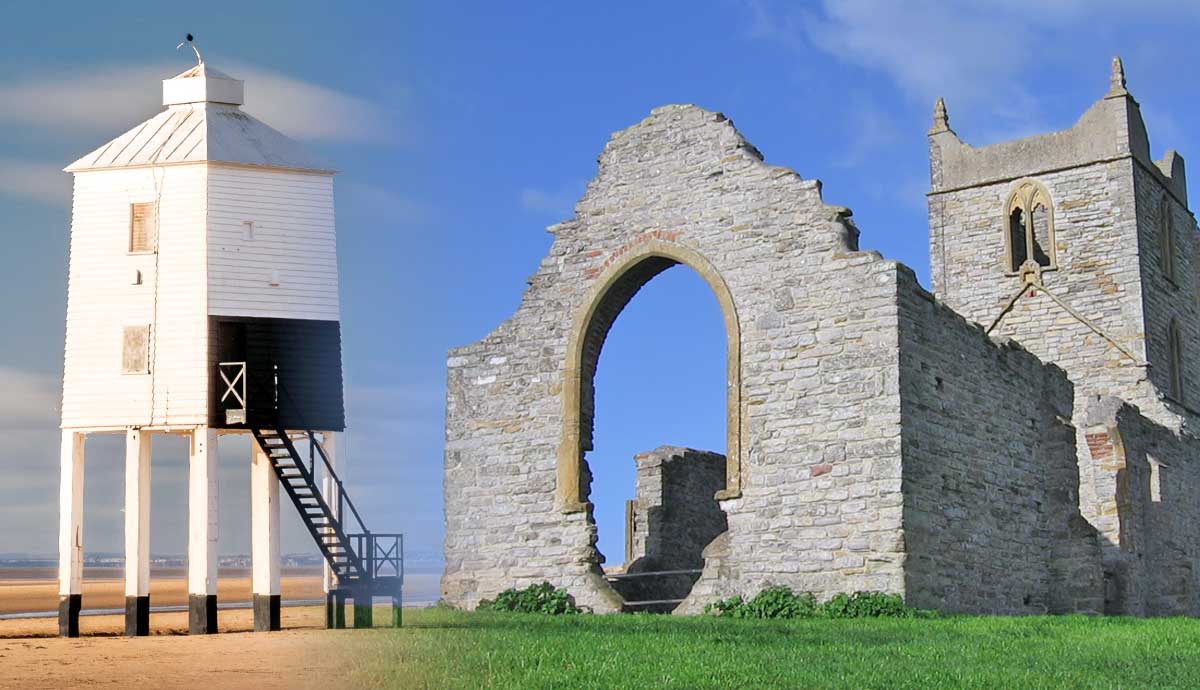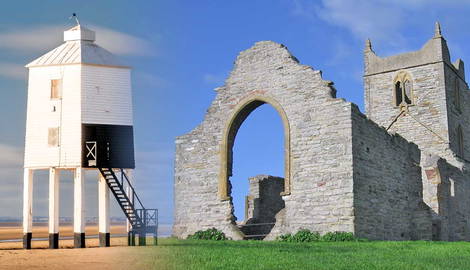
The county of Somerset has a fascinating history; like its neighboring counties, its landscape is shaped by past inhabitants, from Neotholic settlers to Norman invaders. Tales of bravery and resistance permeate those of hardship and grit. Meet the great king who defeated a Viking army and learn of the many castles that met ruin following failed political uprisings. Uncover the stories of English history by exploring a working lighthouse, an old fish house, and “Old Bowlish House.” These are the top seven historical places you must visit in Somerset.
1. Discover the Unique Historical Features of Old Bowlish House

Old Bowlish House is a rather wonderful historical site in Somerset. Built in 1618 and subsequently renovated in 1735 to reflect Georgian styles and again in 1860 to reflect Victorian tastes, this Grade II-listed building has striking features. Its rooms, exterior, and five gardens all boast fascinating histories. The property was built by the Strode dynasty, mostly to showcase the wealth held by the family. Inside, an openwork scroll oak staircase with distinctly Jacobean (1603-1625) carvings connects all three floors. Rooms contain many original features, including fireplaces, furniture, and artwork from the 17th, 18th, and 19th centuries.
The grounds outside contain old industrial buildings and workers’ quarters from when the building served as a clothier’s mansion, and one of the gardens even contains an old ruin. Old Bowlish House also has some war stories of its own; it was occupied in World War II (1939-1945) by the Navy and was caught up in the English Civil Wars (1639-1652). Today, it serves as a family home, with home-owner narrated tours available to visitors.
2. Visit the Only Surviving Monastic Fishery, Meare Fish House

Built sometime in the 1330s for Glastonbury Abbey, this building is England’s only surviving monastic fishery. Its name, “Meare Fish House,” comes from the “mere” nearby, which was a lake from where the fish were caught. The building was used to dry and salt the fish, but that was not its only purpose; the architecture suggests it served foremost as a house and not as a building for the mass processing or storing of fish produce. This explains the name of “Abbots Fish House,” with historians agreeing it was an official residence for the individual in charge of the fishery.
Over time, the lake was drained, and it had dried out completely by 1718. A fire destroyed much of the internal features of the fish house sometime in the late 19th century. Prior to the establishment of the house, fishing was already rife in the area, likely leading to overfishing and squabbles over fishing rights. Records show that Glastonbury Abbey eventually won the fishing rights over the valuable freshwater fish, so Meare Fish House was most probably built to maintain order and keep control over the lake and any competing fisherman. Following its listing as a valuable building of historical significance, repairs have been made, and the current owner has permitted public access to the property for visitors to explore this ancient home.
3. Uncover Over 6,000 Years of History at Brean Down Fort

Brean Down was once home, or perhaps merely saw passage of wooly rhinos and mammoths. Evidence of settlers from as early as the Stone Age can also be found, including the Neolithic period (4500-2500 BCE). Visitors walking over the summit of the down will be able to spot “The Potter’s Mound,” which is a Bronze Age (2500-600 BCE) burial site and most likely the resting place of an important individual. Although there is nothing but bare ground between the path and the mound, excavations have uncovered a Roman Temple. Buried underfoot, it was built around 340 CE. Excavations in 1958 found that it was most probably deconstructed half a century later by the Romans themselves. Much of the stone was then removed and carted off for use elsewhere.
Jumping forward several lifetimes to a period when the English feared an invasion by Napoleon, we see the construction of a new defensive building. Many coastal fortifications were erected to help fend off Napoleon’s attack, including the Palmerston Fort at Brean Down. Although Napoleon’s armies never arrived, the Palmerston found use in more recent times. Today, there are many gun platforms on the site, and these would have housed artillery to defend the Bristol Channel during World War II (1939-1945). A large concrete arrow can be found atop the down, painted white, that was used by practicing bomber planes, helping them to find their practice ranges. Machine gun emplacements mark where soldiers would have undertaken their own target practice during the same period. The fort has since been decommissioned and mostly left to ruin. It is open to the public to explore, and visitors can also walk across Brean Down to discover more traces of history.
4. Meet the Low Lighthouse Keeping Sailors Safe Off the Coast at Burnham-on-Sea

The aptly named “lighthouse on legs” in Burnham-on-sea was built in 1832 when its nearby neighbor, a pillar lighthouse, was discovered to be ineffective for some vessels traversing the channel. Upon the Low Lighthouse’s completion, the pair operated together for 137 years, after which the High Lighthouse underwent modifications, enabling it to do the job of both lighthouses. The lighthouse on legs was decommissioned, but in 1993, it was brought back into service, and the High Lighthouse’s working life came to an end.

The Low Lighthouse has an iconic design, standing 9 meters tall and mounted on 9 timber pilings. It is painted white with a vertical red stripe–much like a racing stripe–on its front face. It is topped with a conical roof, and the combination of all its features give it quite a lot of character. At nearly 200 years old, it is still an active navigational aid for vessels on the channel.
5. Climb the Dips & Troughs Outlining the Remains of Nether Stowey Castle

Following the Norman conquest of Britain in 1066, the Briton’s new rules set about establishing several fortified buildings, one of which was Stowey Castle. As the castle no longer stands, locals now name it “The Mount,” but when “Nether Stowey Castle” was first erected in the 11th century, its square keep would have protruded from the top of the hill, looking out of the surrounding area. A forged charter, dated 1154, contains the earliest mention of the castle. Prior to that, Domesday records, completed in 1086, indicate that the Norman Lord of Stowey was a Norman man called Alfred of Spain. The Domesday records show that Alfred of Spain held estates across many English counties, including Gloucestershire, Wiltshire, Devon, and Dorset.
Foundations of the keep are now listed buildings, warranting special protection. The castle was built in typical Norman motte and bailey style with a keep surrounded by an outer and inner bailey, or wall. Amateur excavators attempted to explore the motte in the 19th century, and mounds found near the area are thought to have been caused by their excavation efforts. An alternative theory is that those little mounds are remains from the castle itself, marking positions where towers may have once stood. It is believed that the castle was largely destroyed in a punitive move by the English authorities following the quashing of the Second Cornish Rebellion of 1497. A local Lord, James Tuchet, the 7th Baron of Audley, was involved in the uprising and was put to death via capital punishment.
6. Visit the Isle of Athelney to See King Alfred’s Monument

From the turn of the 7th century, Viking invasions on English soil became increasingly prevalent, and the English largely struggled to fend them off. This was because from the end of Roman rule in 449 CE, England was largely governed by a Heptarchy (seven petty kingdoms). This period, known as the Dark Ages, came to an end when Egbert of Wessex united the Anglo-Saxon kingdoms in 829. In 865, the Great Heathen army made up of mostly Danish Vikings, invaded the coast of East Anglia and captured York. In 871, the now reinforced Viking army split, with the Danish King Guthrum leading one-half to Wessex. In 878, King Guthrum’s army fought and lost to King Alfred of Wessex in the Battle of Edington.
Treaties, including the Treaty of Alfred and Guthrum of 886, helped formalize boundaries between the two sides; however, Alfred the Great would eventually push back against the Vikings to retake York. Although the Viking settlements and raids would not come to an end until 1152, King Alfred founded Athelney Abbey in celebration of his victory. The Abbey was built in 888 on the Isle of Athelney, named as such due to the impassable swampy marshes that surrounded it. The Abbey was reduced to rubble in 1539 under Henry VIII’s Dissolution of the Monasteries. In 1801, King Alfred’s Monument was erected atop the isle, indicating where the Abbey once stood and marking a time in history when Alfred the Great successfully resisted the Danish invaders.
7. Wander the Ruins of a 500-Year-Old Church at Burrow Mump

Situated where the River Tone and River Cary joined the River Parrett, Burrow Mump is the hill on which the ruins of St Michael’s Church stand, looking out across Southlake Moor. It is thought that the Romans once occupied this strategic position, and several centuries later, another masonry building stood atop Burrow Mump, most likely sometime in the 12th century. A medieval church was erected in the 15th century; however, the church ruins visible today are from a rebuild project from 1793 that was later halted and abandoned. The medieval church is thought to have offered protection to the royalist army during the English Civil Wars (1639-1652). Despite being left to ruin in the 19th century, the church walls are still erect, and intricate details are still visible in the stone architecture. Like many of the historical sites in Somerset, the old church stands proud and is a beacon of the county’s long and colorful history that spans many thousands of years.










